
35 Results

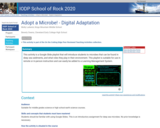
This activity is a Google Slide playlist that will introduce students to microbes that can be found in deep sea sediments, and what roles they play in their environment. This playlist is suitable for use in remote or in-person instruction and can easily be added to a Learning Management System.
Provenance: Molly Ludwick, Kings Mountain Middle School
Reuse: This item is offered under a Creative Commons Attribution-NonCommercial-ShareAlike license http://creativecommons.org/licenses/by-nc-sa/3.0/ You may reuse this item for non-commercial purposes as long as you provide attribution and offer any derivative works under a similar license.
(Note: this resource was added to OER Commons as part of a batch upload of over 2,200 records. If you notice an issue with the quality of the metadata, please let us know by using the 'report' button and we will flag it for consideration.)
- Subject:
- Biology
- Life Science
- Oceanography
- Physical Science
- Material Type:
- Activity/Lab
- Homework/Assignment
- Provider:
- Science Education Resource Center (SERC) at Carleton College
- Provider Set:
- Teach the Earth
- Author:
- Beverly Owens
- Molly Ludwick
- Date Added:
- 08/05/2022
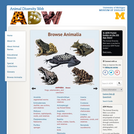
This site is a searchable encyclopedia of thousands of photos, descriptions, sound recordings, and other information about individual animal species. Find out about amphibians, arthropods, birds, fishes, insects, mammals, mollusks, reptiles, and sharks. Explore special features on mammals, skulls, and frog calls. Students are invited to contribute.
- Subject:
- Life Science
- Zoology
- Material Type:
- Diagram/Illustration
- Provider:
- NSDL Staff
- Date Added:
- 11/06/2008
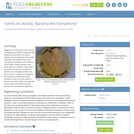
Students are introduced to the concept of engineering biological organisms and studying their growth to be able to identify periods of fast and slow growth. They learn that bacteria are found everywhere, including on the surfaces of our hands. Student groups study three different conditions under which bacteria are found and compare the growth of the individual bacteria from each source. In addition to monitoring the quantity of bacteria from differ conditions, they record the growth of bacteria over time, which is an excellent tool to study binary fission and the reproduction of unicellular organisms.
- Subject:
- Applied Science
- Biology
- Chemistry
- Engineering
- Life Science
- Physical Science
- Technology
- Material Type:
- Activity/Lab
- Provider:
- TeachEngineering
- Provider Set:
- TeachEngineering
- Author:
- Janet Yowell
- Jasmin Hume
- Date Added:
- 09/18/2014

This lesson plan is written around a brief role-play in which students learn about and act out plants and animals in a salt marsh habitat as the tides change.
(Note: this resource was added to OER Commons as part of a batch upload of over 2,200 records. If you notice an issue with the quality of the metadata, please let us know by using the 'report' button and we will flag it for consideration.)
- Subject:
- Biology
- Chemistry
- Life Science
- Physical Science
- Material Type:
- Activity/Lab
- Provider:
- Science Education Resource Center (SERC) at Carleton College
- Provider Set:
- Teach the Earth
- Author:
- Rebecca Teed
- Date Added:
- 02/02/2021
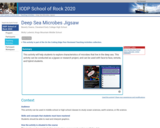
This activity will help students to explore characteristics of microbes that live in the deep sea. This activity can be conducted as a jigsaw or research project, and can be used with face-to-face, remote, and hybrid students.
Provenance: Beverly Owens, Cleveland Early College High School
Reuse: This item is offered under a Creative Commons Attribution-NonCommercial-ShareAlike license http://creativecommons.org/licenses/by-nc-sa/3.0/ You may reuse this item for non-commercial purposes as long as you provide attribution and offer any derivative works under a similar license.
(Note: this resource was added to OER Commons as part of a batch upload of over 2,200 records. If you notice an issue with the quality of the metadata, please let us know by using the 'report' button and we will flag it for consideration.)
- Subject:
- Biology
- Life Science
- Oceanography
- Physical Science
- Material Type:
- Activity/Lab
- Lesson Plan
- Provider:
- Science Education Resource Center (SERC) at Carleton College
- Provider Set:
- Teach the Earth
- Author:
- Beverly Owens
- Molly Ludwick
- Date Added:
- 09/03/2022
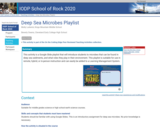
This activity is a Google Slide playlist that will introduce students to microbes that can be found in deep sea sediments, and what roles they play in their environment. This playlist is suitable for use in remote, hybrid, or in-person instruction and can easily be added to a Learning Management System.
Provenance: Molly Ludwick, Kings Mountain Middle School
Reuse: This item is offered under a Creative Commons Attribution-NonCommercial-ShareAlike license http://creativecommons.org/licenses/by-nc-sa/3.0/ You may reuse this item for non-commercial purposes as long as you provide attribution and offer any derivative works under a similar license.
(Note: this resource was added to OER Commons as part of a batch upload of over 2,200 records. If you notice an issue with the quality of the metadata, please let us know by using the 'report' button and we will flag it for consideration.)
- Subject:
- Biology
- Life Science
- Oceanography
- Physical Science
- Material Type:
- Activity/Lab
- Homework/Assignment
- Provider:
- Science Education Resource Center (SERC) at Carleton College
- Provider Set:
- Teach the Earth
- Author:
- Beverly Owens
- Molly Ludwick
- Date Added:
- 08/04/2022
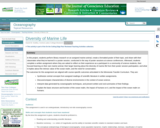
In this project, students perform library research on an assigned marine animal, create a formatted poster of their topic, and share with their classmates what they've learned in a poster session, conducted in the way of poster sessions at science conferences. Afterward, students complete a written assignment where they are asked to reflect on their experience as a participant in a community of science students, their focused learning on their own marine animal, their larger learning about the diversity of marine life from their poster session participation, and what it implies about the intrinsic value of the ocean realm, and the need for conservation.
The outcomes for this assignment are aligned with course-specific outcomes articulated in the Minnesota Transfer Curriculum. They are:
Synthesize central concepts from assigned readings of scientific literature in written assignments.
Discuss/compare characteristics of diverse environments in the context of ocean science.
Interpret data generated by oceanographic techniques, and present written and oral summaries of their findings.
Explain the basic structure and function of the ocean realm, the impact of humans on it, and the impact of the ocean realm on humans.
(Note: this resource was added to OER Commons as part of a batch upload of over 2,200 records. If you notice an issue with the quality of the metadata, please let us know by using the 'report' button and we will flag it for consideration.)
- Subject:
- Biology
- Life Science
- Oceanography
- Physical Science
- Material Type:
- Activity/Lab
- Provider:
- Science Education Resource Center (SERC) at Carleton College
- Provider Set:
- Teach the Earth
- Author:
- David Kobilka
- Date Added:
- 08/29/2019
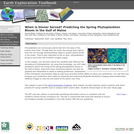
DATA: Ocean Buoy Data, MODIS Images TOOLS: GoMOOS Online Graphing Tool SUMMARY: Learn about conditions that influence the spring phytoplankton bloom. Use an online graphing tool to predict the date of the bloom.
(Note: this resource was added to OER Commons as part of a batch upload of over 2,200 records. If you notice an issue with the quality of the metadata, please let us know by using the 'report' button and we will flag it for consideration.)
- Subject:
- Biology
- Chemistry
- Geoscience
- Hydrology
- Life Science
- Physical Science
- Material Type:
- Activity/Lab
- Data Set
- Diagram/Illustration
- Interactive
- Lesson Plan
- Provider:
- Science Education Resource Center (SERC) at Carleton College
- Provider Set:
- Teach the Earth
- Author:
- Amy Holt Cline
- Denise Blaha
- Date Added:
- 12/11/2020
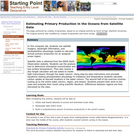
In this computer lab, students use satellite imagery, daylength information, and phytoplankton physiology models to calculate annual primary production for an assigned ocean region.
Satellite data is obtained from the NASA Earth Observation website. Students use the analysis tool to determine chlorophyll concentration and sea surface temperature. They also receive a day-length calculator and are asked to model light transmission through the water column. Using step-by-step instructions and proviede equations relating phytoplankton physiology to irradiance and temperature students calculate carbon uptake at discreet locations in the water column. The second half of the exercise involves scaling up to the entire water column, region, and season. Students present their work to the class and evaluate their result using scientific literature. Differences between regions are then discussed by the class.
(Note: this resource was added to OER Commons as part of a batch upload of over 2,200 records. If you notice an issue with the quality of the metadata, please let us know by using the 'report' button and we will flag it for consideration.)
- Subject:
- Biology
- Chemistry
- Geoscience
- Life Science
- Mathematics
- Measurement and Data
- Oceanography
- Physical Science
- Material Type:
- Activity/Lab
- Data Set
- Lesson Plan
- Provider:
- Science Education Resource Center (SERC) at Carleton College
- Provider Set:
- Teach the Earth
- Author:
- Kevin Arrigo
- Lindsey Kropuenske
- Richa
- Date Added:
- 06/16/2022

This course explores recent historical and anthropological approaches to the study of medicine and biology. Topics might include interaction of disease and society; science, colonialism, and international health; impact of new technologies on medicine and the life sciences; neuroscience and psychiatry; race, biology and medicine. Specific emphasis varies from year to year.
- Subject:
- Arts and Humanities
- History
- Material Type:
- Full Course
- Provider Set:
- MIT OpenCourseWare
- Author:
- Helmreich, Stefan
- Jones, David
- Date Added:
- 02/01/2013
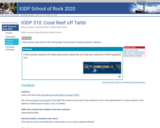
In this activity, students will make observations about the core that was collected on IODP expedition 310.
Provenance: Beverly Owens, Cleveland Early College High School
Reuse: This item is offered under a Creative Commons Attribution-NonCommercial-ShareAlike license http://creativecommons.org/licenses/by-nc-sa/3.0/ You may reuse this item for non-commercial purposes as long as you provide attribution and offer any derivative works under a similar license.
(Note: this resource was added to OER Commons as part of a batch upload of over 2,200 records. If you notice an issue with the quality of the metadata, please let us know by using the 'report' button and we will flag it for consideration.)
- Subject:
- Biology
- Geology
- Life Science
- Physical Science
- Material Type:
- Activity/Lab
- Provider:
- Science Education Resource Center (SERC) at Carleton College
- Provider Set:
- Teach the Earth
- Author:
- Beverly Owens
- Molly Ludwick
- Date Added:
- 08/04/2022
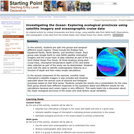
Show caption
HideA screen-shot from Google Earth showing chlorophyll concentrations in the equatorial Pacific. This is the data that students use in the exercise. Details In this activity, students are split into groups and assigned different ocean regions. These include the Arabian Sea, Equatorial Pacific, North Atantic, and Southern Ocean. Each group uses Google Earth to view NASA satellite chlorophyll imagery and the cruise track of data collected as part of the U.S. Joint Global Ocean Flux Study. At three locations along each cruise track, chlorophyll-temperature-depth (CTD) and bottle data collected as part of the study can be downloaded. Students work with the data to identify oceanographic features as a function of depth and then make simple calculations.
In the second component of the exercise, monthly mean chlorophyll a satellite imagery is also included and students speculate about the annual cycle of physical and biological processes based on that time series. Students compile the results into a presentation for the class. Each group should have different responses to the questions asked and different results for the calculations because each ocean region is very different. This easily leads into a discussion about the major ecological provinces of the ocean and what factors cause variability.
(Note: this resource was added to OER Commons as part of a batch upload of over 2,200 records. If you notice an issue with the quality of the metadata, please let us know by using the 'report' button and we will flag it for consideration.)
- Subject:
- Biology
- Geoscience
- Life Science
- Mathematics
- Measurement and Data
- Oceanography
- Physical Science
- Material Type:
- Activity/Lab
- Data Set
- Lesson Plan
- Provider:
- Science Education Resource Center (SERC) at Carleton College
- Provider Set:
- Teach the Earth
- Author:
- Kevin Arrigo
- Lindsey Kropuenske
- Richa
- Date Added:
- 06/16/2022
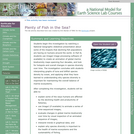
Students begin this investigation by watching several short videos and reading a NOAA article to learn about some some of the ways that declining fish populations have come to be, what fishing management and sustainable catches mean, and how the U.S. established fisheries to monitor fishing. In Part B, students examine graphs and read data maps to explore how the increase in the global number of fishing vessels and the ability for fishing to take place over more of the global ocean by more people than ever before led to a decline in the numbers of fish available. The investigation concludes with students reading the data from the UN's FAO to learn about how fish are used after they're caught - both for food and non-food uses.
(Note: this resource was added to OER Commons as part of a batch upload of over 2,200 records. If you notice an issue with the quality of the metadata, please let us know by using the 'report' button and we will flag it for consideration.)
- Subject:
- Biology
- Ecology
- Geoscience
- Life Science
- Physical Science
- Material Type:
- Activity/Lab
- Diagram/Illustration
- Interactive
- Provider:
- Science Education Resource Center (SERC) at Carleton College
- Provider Set:
- Teach the Earth
- Date Added:
- 07/13/2022

In this activity, students examine hydra, a fresh-water relative of coral, under a microscope to observe feeding behavior and identify stinging cells that are characteristic of corals. They also learn more about the individual animals that make up coral reefs and construct simple models of coral polyp anatomy and feeding behavior.
(Note: this resource was added to OER Commons as part of a batch upload of over 2,200 records. If you notice an issue with the quality of the metadata, please let us know by using the 'report' button and we will flag it for consideration.)
- Subject:
- Biology
- Geoscience
- Life Science
- Oceanography
- Physical Science
- Zoology
- Material Type:
- Activity/Lab
- Provider:
- Science Education Resource Center (SERC) at Carleton College
- Provider Set:
- Teach the Earth
- Date Added:
- 03/31/2021
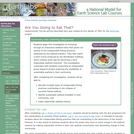
Students begin this investigation with an introduction to the types of fishing gear and how its use has changed over time. Students learn about irresponsible fishing practices and methods that can be used to make fishing more sustainable. They then watch a short video produced by PBS FlipSide Science, which outlines some tips for becoming a more responsible seafood consumer. The investigation culminates with students conducting an independent group research project exploring the availability of sustainable seafood in their community.
(Note: this resource was added to OER Commons as part of a batch upload of over 2,200 records. If you notice an issue with the quality of the metadata, please let us know by using the 'report' button and we will flag it for consideration.)
- Subject:
- Biology
- Geoscience
- Life Science
- Physical Science
- Material Type:
- Activity/Lab
- Simulation
- Provider:
- Science Education Resource Center (SERC) at Carleton College
- Provider Set:
- Teach the Earth
- Date Added:
- 03/31/2021
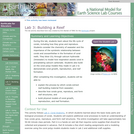
During this lab, students learn about the life cycle of corals, including how they grow and reproduce. Students consider the chemistry of seawater and the importance of the symbiotic relationship between corals and zooxanthellae in the formation of coral reefs. They blow CO2 through calcium hydroxide (limewater) to model how respiration assists coral in precipitating calcium carbonate. Students also build on the coral polyp models they made in Lab 2 to demonstrate coral growth, reproduction, and reef formation.
(Note: this resource was added to OER Commons as part of a batch upload of over 2,200 records. If you notice an issue with the quality of the metadata, please let us know by using the 'report' button and we will flag it for consideration.)
- Subject:
- Biology
- Chemistry
- Geoscience
- Life Science
- Oceanography
- Physical Science
- Zoology
- Material Type:
- Activity/Lab
- Provider:
- Science Education Resource Center (SERC) at Carleton College
- Provider Set:
- Teach the Earth
- Date Added:
- 03/31/2021
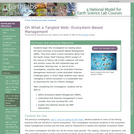
Students begin this investigation by reading about the basic premises of Ecosystem-Based Management (EBM) and how it can be applied to fisheries management — Ecosystem-Based Fisheries Management (EBFM). In Part B of the investigation, students learn about Integrated Ecosystem Assessments and how they are used as a tool for ecosystem-based fisheries management.
(Note: this resource was added to OER Commons as part of a batch upload of over 2,200 records. If you notice an issue with the quality of the metadata, please let us know by using the 'report' button and we will flag it for consideration.)
- Subject:
- Biology
- Ecology
- Geoscience
- Life Science
- Physical Science
- Material Type:
- Activity/Lab
- Diagram/Illustration
- Interactive
- Provider:
- Science Education Resource Center (SERC) at Carleton College
- Provider Set:
- Teach the Earth
- Date Added:
- 09/03/2020

Corals, like other living animals, require a particular range of environmental conditions to survive. In this lab, students examine sea surface temperature, depth, salinity, and aragonite saturation data to discover coral reefs' favored environments.
(Note: this resource was added to OER Commons as part of a batch upload of over 2,200 records. If you notice an issue with the quality of the metadata, please let us know by using the 'report' button and we will flag it for consideration.)
- Subject:
- Biology
- Chemistry
- Geoscience
- Life Science
- Oceanography
- Physical Science
- Material Type:
- Activity/Lab
- Provider:
- Science Education Resource Center (SERC) at Carleton College
- Provider Set:
- Teach the Earth
- Date Added:
- 09/26/2022
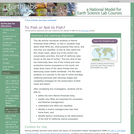
This lab activity introduces students to Marine Protected Areas (MPAs). In Part A, students read about what MPAs are, what purposes they serve, and how they are classified. In Part B, they learn about the Gulf of California (also known as the Sea of CortÃs). This tiny strip of sea has historically been one of the richest and most productive marine ecosystems in the world, but today faces many of the same threats that are destroying ocean health worldwide. Students watch short videos and read about challenges of new MPAs in the area as well as about Cabo Pulmo, which has been an MPA since 1995.
(Note: this resource was added to OER Commons as part of a batch upload of over 2,200 records. If you notice an issue with the quality of the metadata, please let us know by using the 'report' button and we will flag it for consideration.)
- Subject:
- Biology
- Ecology
- Geoscience
- Life Science
- Physical Science
- Material Type:
- Activity/Lab
- Diagram/Illustration
- Provider:
- Science Education Resource Center (SERC) at Carleton College
- Provider Set:
- Teach the Earth
- Date Added:
- 03/31/2021